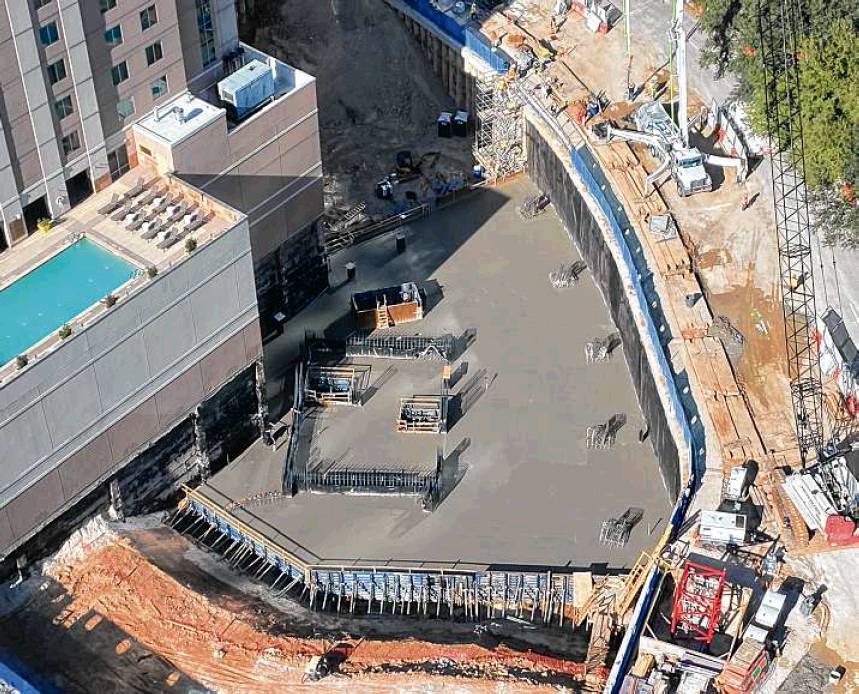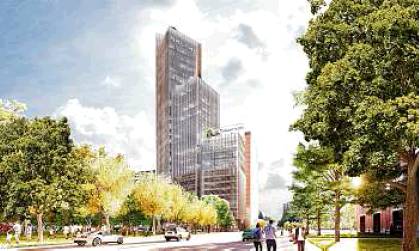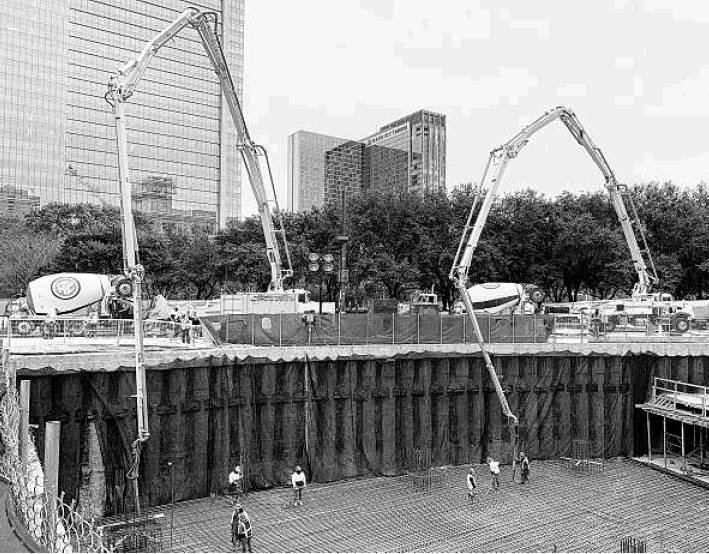ENVIRONMENT
Cutting carbon is goal for new office tower
Skanska USA’s downtown project has one of the greenest footprints in Texas
By Marissa Luck STAFF WRITER
Walking through Discovery Green Park, it’s not hard to miss the sounds of rumbling of equipment, the sight of red cranes reaching above tree line, and the sense of progress from the newly poured foundation for downt own’s newest office tower. What’s less visible though is the behind-the-scenes planning going into making 1550 on the Green Skanska USA’s greenest office project in Texas.
That foundation, for example, uses concrete that significantly reduces the use of carbon-intensive cement. That is one of the hundreds of more sustainable building materials Skanska will employ as it aims to reduce the carbon emissions tied to the building’s construction by 60 percent.
With 1550 on the Green, Skanska USA, the U.S. subsidiary of Swedish construction company, is helping to spearhead a national effort to get more real estate companies to address embodied carbon — or the carbon emissions produced in extracting raw materials, transporting them to factories and manufacturing building products.
1550 on the Green is Skanska’s first project in Houston to use a free, open-source tool, called the Embodied Carbon in Construction Calculator (EC3), to estimate and reduce the embodied carbon in the future 28-story tower where contractors recently started above-ground construction.
Buildings account for 39 percent of global greenhouse gas emissions, according to the Global Alliance for Buildings and Construction, so reducing emissions tied to real estate is key for companies and governments trying to reach certain emission reduction targets in effort to slow climate change. For an average new building, the carbon that goes into making building materials is roughly equivalent to all the carbon tied to heating, cooling and power the building for 30 years, according to Skanska.
While real estate developers have for years focused on reducing emissions tied to running the building — think low-flush toilets and energy-efficient lighting — the concept of carefully examining embodied carbon only started gaining traction in the last decade or so. Renovating existing buildings and reusing materials is considered the best way to reduce embodied carbon, but developers also are looking to cut embodied carbon emissions in new building construction.
“Embodied carbon is turning out to be a huge piece of the pie [for reducing building emissions]. Skanska is a real leader in this, and they’ve been a kind of a pioneer when it comes to reducing embodied carbon of their developments,” said Marta Schantz, senior vice president at the Urban Land Institute, a Washington think tank. Typically, embodied carbon accounts for about half of a building’s overall emissions profile, Schantz added.
Skanska isn’t alone. Other firms, including Kilroy Realty of Los Angeles, Hudson Pacific Properties also of Los Angeles, Alexandria Real Estate of Pasadena, Calif., Brookfield Properties of New York, and Lendlease of Sydney, are taking steps to reduce embodied carbon in their projects as more tenants seek buildings with smaller carbon footprints and governments consider embodied carbon standards, Schantz said.
“It’s becoming more and more common across some of the more progressive real estate developers who are thinking ahead and planning for future where they need to meet carbon reduction goals and a future where they expect local government to be setting embodied carbon reduction targets,” Schantz said.
Launched in 2019, the EC3 tool relies on a growing database of more than 80,000 building materials. It allows developers to see a breakdown of the carbon emissions that went into manufacturing the building material . Contractors can compare the carbon emissions of individual products by region to procure the lowest-emitting product and create designs with lower emissions.
Nearly 20,000 professionals are registered to use the tool, said Stacy Smedley, who helped to co-develop the EC3 tool with Skanska and now executive director of the nonprofit, Building Transparency, which manages the tool.
Other embodied carbon tools are on the market, but EC3, provides a user-friendly, free resource to track the emissions of individual products based on environmental data verified by a third-party, industry officials and experts said.
The EC3 tool doesn’t consider the carbon emissions produced in transporting materials from the factory to the construction site. And while the database is large and growing, it is not exhaustive. It has more data for suppliers in California and Washington state than it does for Texas, where suppliers are just starting to become more transparent about embodied carbon. The database, for example, includes several thousand cement products made in California plants but fewer than 100 in Texas.
For 1550 on the Green, Skanska plans to use the EC3 tool to evaluate the embodied carbon not only in the most carbon-intensive materials (concrete and rebar) but also in other products used throughout the project (including aluminum, roofing material, carpeting and ceiling tiles). The analysis will help the company pick and choose the least carbon-emitting materials.
“With projects like 1550 on the Green, and other Skanska led projects in Texas, we are really beginning to move the needle by growing supplier interest in [embodied carbon] and looking at how the carbon footprint of their product might size up against that of their competitors,” said Matt Damborsky, executive vice president at Skanska USA. “We are excited …to bring more transparency.” marissa.luck@chron.com, twitter.com/marissaluck7


